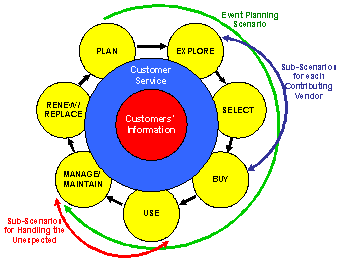How Customers Want to Plan a Special Event
Identifying and Measuring the Key Moments of Truth in "Event Planning" Customer Scenario® Patterns
Customer scenarios fall into patterns. It’s valuable to know these patterns ahead of time so that you’ll know what kinds of customer and operational metrics to elicit. Then you can focus on how to differentiate the experience, products, and services you offer to help customers reach their goals. This report focuses on the moments of truth and metrics in a typical event-based event planning scenario.
NETTING IT OUT
Over the past year, we have looked at the patterns in customer lifecycle scenarios. We use the term customer lifecycle the way it is typically used in marketing: the lifecycle of a customer’s interactions with a product or service from planning through buying, using and renewing or replacing. In this report, we provide our first pattern for a different kind of scenario: these are scenarios that correspond to a customer’s event-based activity, like moving a home or office, preparing for the birth of a child, or launching a product.
We begin this series with a Customer Scenario Pattern for planning and running parties, celebrations, and other special events. Unlike lifecycle scenarios, which typically span one to two lifecycle phases (e.g., explore/select, or select and buy, or use/maintain), event-based activity scenarios tend to go through six of the seven lifecycle stages, from planning through managing the event. And within our “planning a special event” scenario, there are many microcosms of the lifecycle, where, for example, you explore/select/buy/use a multitude of products and services, all of which are vital to the success of the event.
Although the reasons for special events vary widely, and each has its own context, details, and requirements, there are still a number of key factors that are vital in any event planning scenario. For almost any event, the customer typically has five key things that he wants:
- I have help coordinating the entire event
- I am confident that everything is done on time
- The event is within budget
- The event runs smoothly
- The event is a success
We call these the customer’s “Moments of Truth” (a.k.a. “showstoppers”); if you don’t address these issues crisply, you risk losing your customer forever.
Once you recognize the common moments of truth, you can identify the types of customer metrics and operational metrics that measure how successful you are at meeting your customers’ ultimate goals for doing business with you. Then you can focus your co-design activities on how to differentiate the experience, products, and services you offer to help customers reach those goals.
Identifying the metrics allows you to recognize:
- How the customer will be “grading” you
- How you grade yourself in helping the customer be successful
- How you can identify and measure business opportunities that can result from providing a great customer experience
A TYPICAL “SPECIAL EVENT PLANNING” CUSTOMER SCENARIO
Infrequent Events
You don’t plan a special event every day—thus the term “special” event. Typically, you do everything one time per event, and most people plan and execute special events a small number of times in their lives. True, if you are a professional party planner, or if you are the events coordinator for a company or organization, you often repeat the process. But most people plan things like a wedding, a company launch, and a charity ball relatively few times. Therefore, as a supplier for these types of events, you typically only have one chance to do it right for the customer. And, because of the specialness of the situation, the stakes are always very high. Failure is not an option.
Spans Most Lifecycle Phases
Planning a special event begins with, obviously, the Plan stage of the customer lifecycle. Customers then explore their options, select which products and services they want for the event, buy or rent these products/services, and use them at the actual event. The final stage is managing the event as it happens. In fact, the only lifecycle stage that rarely comes into play in this type of scenario is renewing or replenishing. (This last phase does come into effect for professional event coordinators who take advantage of economies of scale in anticipation of multiple similar events.) (See Illustration 1.)
The Customer Lifecycle
© 2008 Patricia Seybold Group
Illustration 1. The customer lifecycle begins with customers looking for solutions and continues to their planning for the next product/service solution that they need, leading, again, to the exploration phase. Most customer scenarios span two or three of the phases. However, planning an event begins with the Plan stage and moves all the way through the Manage phase. Within the overall event planning scenarios are multiple sub-scenarios that typically follow a standard select and buy scenario pattern or span the use and manage phases when changes must be implemented.
Many Sub-Scenarios
Event-triggered scenarios typically have many sub-scenarios as they progress through the customer lifecycle. For example, when planning a party, you need to go through the entire lifecycle (minus replenishment) for things like food, décor, venue, etc. That’s one of the reasons that special event planning is such a consuming job, requiring a high level of coordination. Indeed, any event-based scenario usually requires that high degree of coordination, whether planning a wedding, moving into a new home, or starting a business...(more)
(Download the PDF to read the entire article.)
Sign in to download the full article
0 comments
Be the first one to comment.




